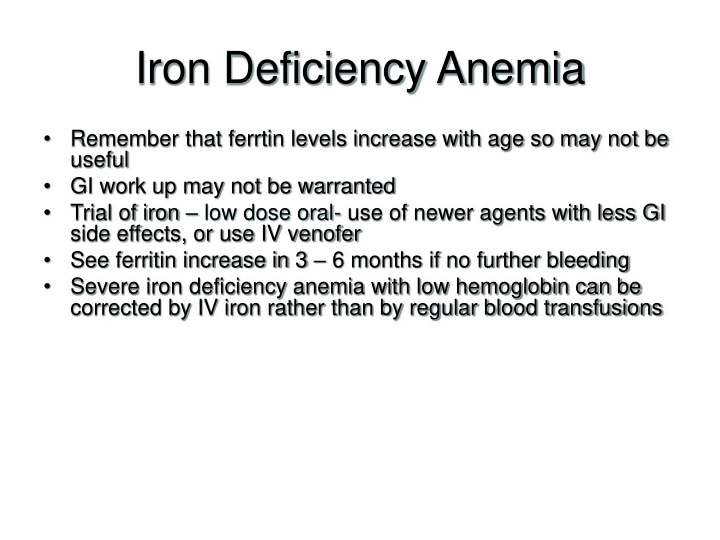



Iron Deficiency Anemia • Remember that ferrtin levels increase with age so may not be useful • GI work up may not be warranted • Trial of iron – low dose oral- use of newer agents with less GI side effects, or use IV venofer • See ferritin increase in 3 – 6 months if no further bleeding • Severe iron deficiency anemia with low hemoglobin can be corrected by IV iron rather than by regular blood transfusions
Low B12 level- Cobalamin deficiency • B12 deficiency common (15%) , anemia is not (1%) - check MCV • lack of gold standard to measure deficiency- Schilling test extinct! • Clinically important definition is when IF absorption fails = pernicious anemia • Follow up of patients on tx important
Food Cobalamin Deficiency States • CLINICAL • SUBCLINICAL – symptomatic – asymptomatic – B12<100 ( low) – mild low-normal B12 – MMA high – normal MMA – known cause – 50% no cause found – malabsorption of free – food cobal. cobal malabsorption – progressive course – slow course (>10 yrs) – tx needed – tx probably needed – uncommon – dose? – 10-20% of elderly
True B12 Deficiency- Tx • IM 1000 ug weekly or daily oral 1200 ug – 1 week – reticulocytosis – 8 th week – MCV and Hgb correction – 6 th week- 3 months – neuro sx clear • Oral vs IM – Commitment to tx – Monitoring patient compliance – Patient preference- monthly vs daily
Vitamin B12 deficiency • Subclinical – Depends on clinical pretext – No tx needed if no CBC, MCV or IF abnormalities • Prophylaxis – Vegetarians ( esp pregnant) – Gastric surgery ( bariatric ) – Nitrous oxide use – ???elderly – unknown value
Anemia of chronic disease • No specific test to diagnose • New peptide – HEPCIDIN – key to iron regulation and response to inflammation • Response to inflammation may be prolonged even after stimulus gone: • Unique mechanism of ACD anemia in elderly- • ?? Anemia of aging
Unexplained anemia • Epo deficiency ( levels may need to be higher in elderly) • Decrease in body mass – fraility • Decrease in bone marrow cellularity, BFUe • Occult myelodysplasia • Changes in hormones • Polypharmacy , Etoh
Unexplained anemia - Tx • No good trials available • Use of epo +/- iron replacement • Vitamin D • QOL issues – tx risks and benefits need to be discussed with patient and family • Improved QOL vs possible risk of ESA
Hemolysis Sudden onset severe anemia May have no classic sx or signs Causes : Idiopathic Post viral Lymphoproliferative disorder = lymphoma Treatment includes steroids, IVIG , often chronic Transfusions transient effect, but not contraindicated
Myelodysplasia • Debate re – is this cancer? • Clonal disorder resulting in bone marrow failure and possibly AML. • Disease heterogeneity important • +/- effective treatment • 4 new drugs: – Vidaza – Decitabine – Exjade – revlimid
Myelodysplasia Survival for low risk ( refractory anemia ) 33 -70 months Only curative treatment is allogeneic bone marrow transplant Treatment depending on prognostic risk group ( low risk vs preleukemic) Bone marrow NOT always indicated in frail elderly patient especially if tx options limited Most cases of unexplained macrocytic anemia in elderly
Eprex in Anemia • Trial of eprex may be warranted for 8 – 12 weeks , 20,000 u weekly s/c • Side effects: – Hypertension – Thrombosis – Headache – Rare seizure, red cell aplasia ( seen in dialysis patients ) – Recent data disturbing re use in oncology patients and cancer spread • 25% response in MDS • Need to maintain iron stores to be effective
Transfusions in MDS • Many patients remain fatigued despite tx ( Hgb usually 70 – 90 baseline ) • Morbidity higher than expected from chronic transfusions • Avoid drops in Hgb, transfuse regularly • Issue of iron overload – Use of exjade ( diarrhea, $) – Usually no effect on survival in elderly with MDS • Safety of blood transfusions , age of blood …..
Anemia in the Elderly • In conclusion: – Anemia in elderly can be associated with increased mortality and decreased function – Treatment should do more good than harm – Etiology remains multifactorial – Aging population unique re mechanisms of anemia
Hematologic Malignancies in the Elderly • Chronic leukocytosis ( lymphocytosis ) - likely CLL • Pancytopenia, fever, recurrent infections - think acute leukemia • Milder non aggressive treatments exist for lymphoma and CLL – quality of life issues • Transfusional support may be all that is necessary • Need to address prognostic factors in each individual patient to determine treatment options
Recommend
More recommend